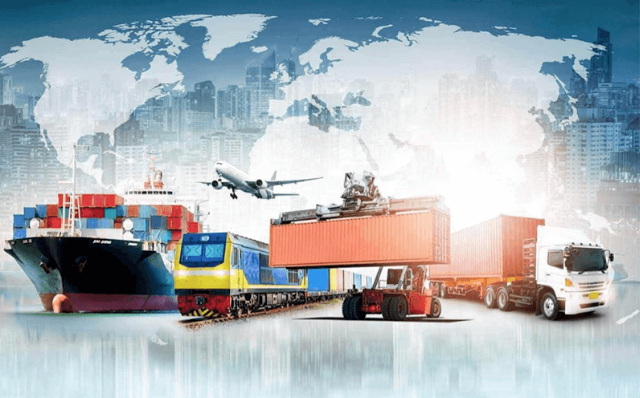Innovation drives entire industries forward as new feature-rich software solutions appear all the time. Numerous companies from the logistics industry are also undergoing a significant change nowadays. With the global digital transformation expenditure poised to soar to a staggering $3.4 trillion by 2026, the numbers speak volumes.
Let’s see what advantages digital transformation in the logistics industry brings to companies worldwide.
Understanding digital transformation in logistics
Modern industries face a choice: they either need to adapt to the ever-growing digitalization or stand still and enjoy what they have achieved already. The first choice demands time, strength, and money but turns out rewarding in the end. Leading logistics companies have chosen adaptation and embraced digital transformation. They are gradually digitizing all their workflows. This means a totally new approach to clients, improved workflows, and accurate and rapid deliveries. By 2027, the global spending on digital transformation in logistics will hit $84.6 billion.
The Digital Industries Barometer survey sheds light on the influence of digital transformation on various sectors of the economy. With a score of 6.61, logistics and transport ranked fifth out of 11 industries on a global scale.
In the beginning, this sector was slow to adopt digital transformation. But recently, there have appeared new companies partnering with IT agencies to build impeccable software and thus improve all vital processes.
However, digital transformation in logistics and supply chains isn’t a single change; it requires the following transformation types: organizational, technological, process, and business model.
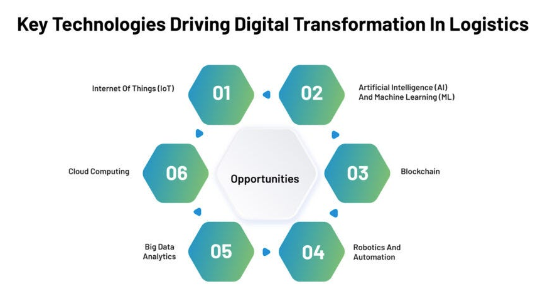
Digital transformation in supply chain management: the importance of data analytics
If you want to achieve access, you must use efficient data analytics tools. They will help you take operations to the next level and thus stay competitive. During the entire process, vast amounts of data are processed. So, you’ll make sound decisions and choose the most suitable options when carrying out your tasks.
Here are some benefits of data analytics:
- Better forecasting
Imagine being able to predict market demand with incredible accuracy. And this is totally possible with data analytics. You can quickly examine past sales, evaluate current market trends, and analyze external factors to understand what’s to come next. Such accurate forecasting considerably optimizes supply chains. If you realize potential risks or trends and know what to expect, you can manage your inventory better. So, you won’t run out of products or have too much in stock.
- Improving inventory management
Companies operating in this industry don’t just store products. They are trying to find the right balance when carrying out all vital tasks. Take, for example, warehouse operations. If you use data analytics, you’ll manage to reduce warehousing costs. Spotting waste, identifying issues, and improving product quality – these are just a few advantages that lead to happier customers.
- Balancing supply and demand
A supply chain is like a finely tuned instrument, ready to adapt to market changes and customer needs. Analytics software helps specialists to match supply and demand more efficiently. They understand where to get supplies, how to transport them, and where to distribute them. You’ll save both money and time as a result.
- Immediate visibility and control
In today’s digital age, nothing stays hidden for long. With data analytics, you enjoy clear visibility and get control over all processes. Modern software monitors inventory, shipments, and suppliers in real time. If there are issues on the horizon, like delays or security risks, data analytics sounds the alarm, ensuring everything runs smoothly.
- Boosting supplier performance
Any supply chain is as strong as its weakest link. Thanks to pioneering tools, you can easily measure service levels, product quality, and on-time delivery. Thus, you secure strong relationships with suppliers, which results in better contract terms and issue resolutions.
- Reducing risks and building resilience
Supply chains face risks at every turn. These can be market disruptions, regulatory changes, or natural disasters. So, you need to constantly identify and assess these threats, and data analytics is a perfect helper in this matter. With it, you obtain contingency plans and thus enhance your resilience. In case of disruptions, the recovery will be fast.
- Continuous improvement
Achieving excellence is not a matter of one day only. You must constantly spot areas that demand improvement and test different scenarios. Thanks to data analytics, all of this is possible.
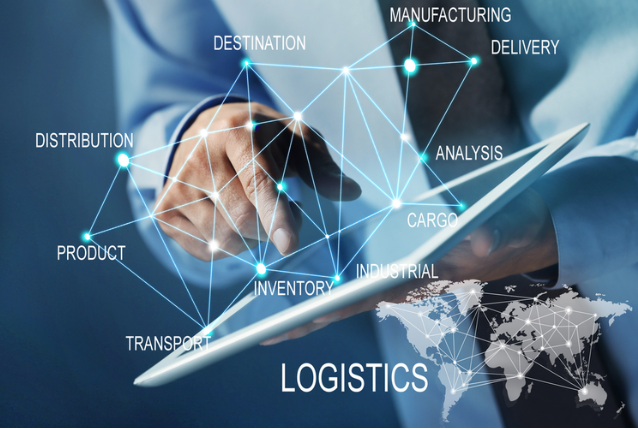
Improving visibility through the IoT and real-time tracking
Modern supply chains are extremely complex. Professionals require a clear understanding of their operations to ensure success. Previously, understanding the whole picture was difficult. Things are becoming easier with the IoT and real-time tracking.
Think of visibility as having a GPS for everything – each vehicle or item. You can effortlessly keep a tab on the movement of goods, equipment, and materials throughout the entire network.
All this is possible thanks to the IoT. A network of interconnected sensors and devices helps you to carry out crucial tasks and enhances your monitoring capabilities. Such devices independently collect data, send them to operators, and don’t need any help from humans. 24/7 monitoring is a prerequisite for improved outcomes. With the IoT, you get a dashboard that shows you everything happening in your supply chain right now.
- Smart assets
The IoT makes your assets ‘smart.’ It adds sensors to things like vehicles, containers, and cargo. And they tell you exactly where your assets are located at this or that moment. No more guessing. Just use this info to build better routes, prevent delays, and ensure your goods arrive safely.
- Improved warehouse operations
Inside your warehouse, the IoT makes inventory management a breeze. It tells you what’s in stock, what’s running low, and what needs restocking. This means no more overstocked shelves or running out of products. Your warehouse runs smoothly.
Warehouses with IoT automation are also worth mentioning. IoT-backed machines do all the work, from picking and packing to sorting. So, no more human mistakes.
- Machinery support
IoT sensors are also crucial for machines and equipment. They collect vital data and predict potential breakages. If you are aware of particular vulnerabilities and risks, you can fix your machinery and equipment before something critical happens.
- Transparency
With the IoT, you get to see your entire workflow, from start to finish. You understand where products are, if there are delays, or if something’s about to go wrong. Such transparency helps you avoid problems.
- Protection of delicate goods and cargo
For goods that need special conditions, IoT is a savior. Temperature, humidity, and other factors are monitored by sensors with great precision. This ensures that sensitive products such as medicines or food remain in the appropriate conditions while transported. The protection of fragile cargo is one more important thing worth mentioning. You will know the exact moment something fragile gets bumped or tilted. IoT sensors can do that. They ensure nothing breaks along the way.
The IoT doesn’t just give data; it helps you use it wisely. By combining this information with smart computer programs, you can plan the best routes for your deliveries. Thus, you will use less fuel, lower costs, and achieve faster deliveries. The IoT doesn’t stop at your door; it reaches your suppliers and vendors too. You can monitor their performance and deliveries in real time.
With the IoT, you are fully prepared for unexpected situations. It helps you spot potential problems early, so you can be prepared. Your supply chain stays strong, no matter what.

AI and ML for predictive maintenance
Picture a world where systems can predict and prevent disruptions before they occur, optimizing workflows like never before.
Logistics has always been a complex puzzle, with countless variables and moving parts. Traditionally, companies had to react to issues as they arose, often leading to costly delays and inefficiencies. That’s where AI and ML come to the rescue.
AI gathers data from various sources and then employs its analytical prowess. It traces patterns and anomalies, raising red flags when something seems strange. Machine learning analyzes the collected data and becomes more adept at recognizing problems. It’s like a detective who’s solved numerous cases and can now spot trouble a mile away.
With AI and ML, systems can foresee their own hiccups. They detect when something isn’t running smoothly, such as a delay in a shipment or an unexpected increase in demand.
Predictive logistics is akin to fixing a leaky boat before it sinks. It saves not only money but also time. If you establish processes in the best possible way, you won’t need to react to emergencies. Just schedule maintenance and adjustments at your convenience – and you’ll minimize costly disruptions. You can do it during periods of low demand, preventing downtime.
Predictive maintenance reduces downtime to a minimum. Equipment is fixed before it breaks, ensuring the uninterrupted flow of goods and services.
Another important aspect is sustainability. Predictive measures reduce waste because you only make changes and adjustments when needed. And it isn’t confined to warehouses and factories; it’s everywhere. Vehicles that alert you to maintenance needs, shipping containers that predict wear and tear – these and other remarkable innovations are transforming industries, making them smarter and more efficient.
AI and ML are advancing at breakneck speed. Soon, logistics systems won’t only predict issues but also autonomously order replacement parts and schedule maintenance.

The influence of blockchain on supply chain transparency
Information gaps, trust concerns, and susceptibility to fraud and counterfeiting are common issues in conventional systems. Thanks to blockchain technology, companies can reach a higher level of transparency, traceability, and security.
Here’s how blockchain enhances transparency during the digital transformation in supply chain management:
- Traceability
By maintaining an unchangeable ledger, blockchain enables comprehensive traceability, recording every transaction, transfer of ownership, and product movement. This information is accessible to each participant.
- Verification of origin
Blockchain enables the authentication of a product’s origin. It captures important information like batch numbers, manufacturing specifics, and certifications. A product’s complete history can be seen by both consumers and businesses.
- Up-to-the-minute visibility
With blockchain, all authorized participants can access a shared, synchronized, and decentralized database that provides real-time visibility into operations.
- Smart contracts
The potential of smart contracts on the blockchain lies in their ability to automate numerous processes, such as payment settlements, quality control, and delivery validation. These contracts eliminate intermediaries, reducing transaction costs while ensuring compliance with predetermined regulations and conditions.
Another important aspect worth mentioning is increased security. When data is stored on a blockchain, it cannot be changed or deleted without agreement from network members. Data integrity is protected, and unauthorized tampering is prevented by immutability acting as a fortress for supply chain information.

Sustainability and green practices
Sustainability is one of the top concerns nowadays. Thanks to robust software tools, companies successfully introduce green practices.
- Smarter routes to reduce emissions
Thanks to pioneering software systems, companies build environmentally friendly routes, reducing fuel usage and emissions. This results in cost savings for operations and a reduction in the industry’s environmental impact.
- Electric vehicles for eco deliveries
EVs for last-mile deliveries are rapidly gaining popularity. Through robust software platforms, operators manage and organize EV fleets. Thus, deliveries are carried out on time, and with reduced emissions.
- Tracking sustainability
Advanced systems offer end-to-end transparency in the supply chain, making it easier to monitor the environmental footprint of every stage.
- Cutting waste
The concept of the circular economy is vital nowadays. It implies reducing, reusing, and recycling. Thanks to data gathered from software, businesses cut down on waste. They optimize packaging materials, remove excess inventory, and recycle and repurpose products.
- Smart warehouses
Automation tools and IoT sensors enhance storage efficiency inside smart warehouses. Companies no longer need extremely large facilities: they can use their space efficiently.
As digital transformation continues to reshape logistics, sustainability will remain a paramount concern. Prioritizing eco-consciousness is not merely an option; it becomes a strategic necessity.
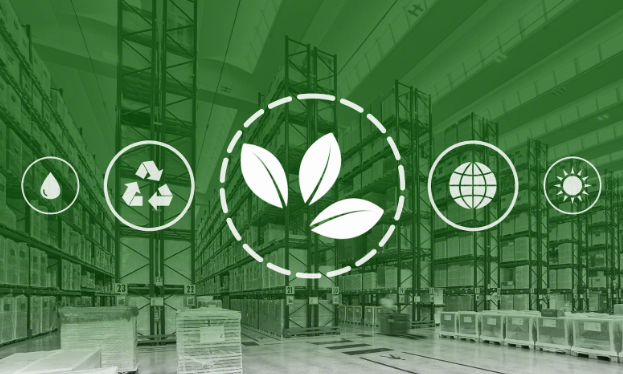
Digital transformation in logistics and supply chain: potential risks and key challenges
The advantages of digital transformation in logistics are substantial. However, if you want to carry it out successfully, you must fully realize all the risks.
- Data security
Insufficient or inadequate cybersecurity measures or outdated software can expose sensitive information, leading to legal and trust issues.
- Cybersecurity threats
Cyberattacks like phishing and ransomware are genuine threats. Neglecting cybersecurity can leave companies vulnerable to these malicious attacks.
- Protecting confidentiality
Logistics relies on safeguarding trade secrets and customer data. Breaches of this information can be disastrous.
- Lack of expertise
Working with software solutions may require specialized skills. Many companies lack an in-house team capable of handling these complexities.
- Resistance to change
Familiar processes can cause resistance to change among both employees and management, leading to delays in adopting efficient solutions.
- Budget constraints
Digital transformation is not cheap. So you must implement it stage by stage and allocate your resources reasonably.
To overcome these challenges and minimize risks, companies should take efficient security measures, carry out regular risk assessments, and adopt a sound growth strategy.
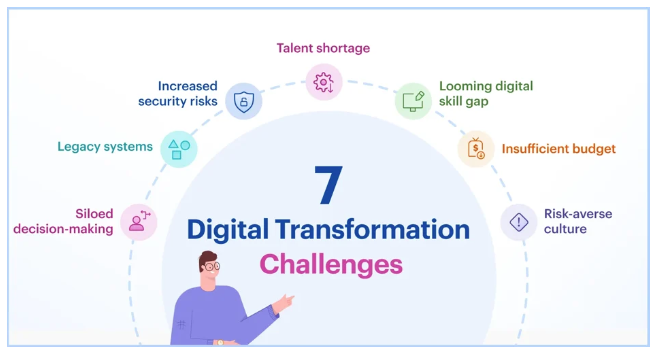
Conclusion
Pioneering software has brought about tremendous changes in the industry. Nowadays, companies stand at the threshold of an exciting era, where innovation is the key to success. Digital transformation in logistics is a must for businesses that want to stay competitive and enhance their operations. And cooperation with a reliable IT company specializing in logistics management software development is a must. Experienced specialists will help you carry out the entire process seamlessly and quickly.




